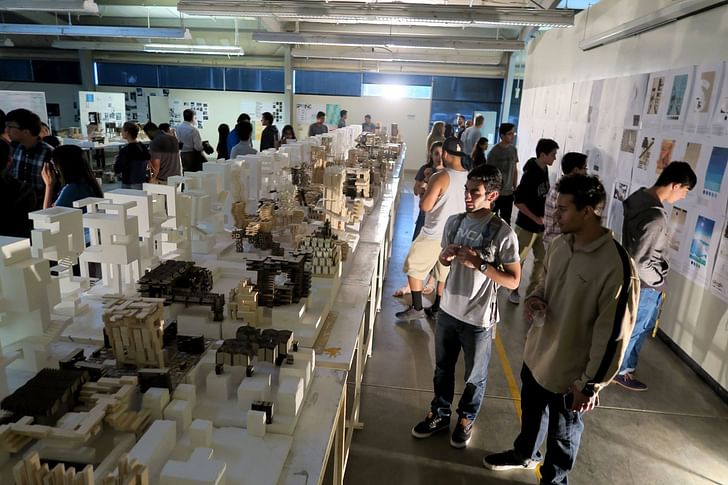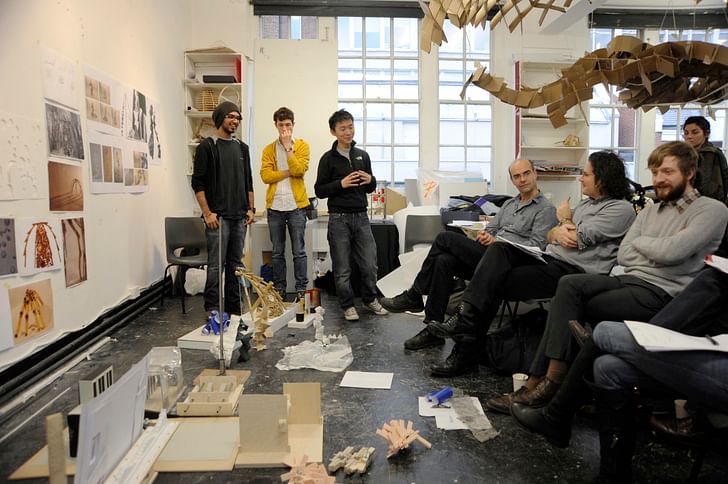

As if running a practice wasn’t challenging enough, numerous architects and designers also engage regularly in teaching, whether it’s giving one-off lectures around the world or teaching full studios and courses at universities. So how does teaching influence the practice of architecture, and vice versa?
Jimenez Lai, director of Bureau Spectacular and lecturer at UCLA, once noted in an interview that he tries to teach his students to “have fun, work hard, and don’t be an asshole.” But it’s not just students who benefit from pragmatically-imbued teaching: as Steven Holl noted, “I feel invigorated by the interaction and dialogue with the students. In a spirit of giving back to the field, the teaching exchange has also kept me on architects that both teach and practice serve as a crucial connective tissuekeen focus with the potentials of architecture as it has changed in the last decades.” While the exchange between practicing architects and their students is often as customized as the aesthetic sensibility of each designer, there are commonalities to the relationship that span across practices and institutions. From Greg Lynn to Toyo Ito to Deborah Berke, architects that both teach and practice serve as a crucial connective tissue between the highly abstract realm of academia and the gritty, oftentimes grinding reality of permits, stakeholder meetings and aesthetic compromises.
To more fully understand how this relationship functions, I spoke to Sarah Lorenzen, chair of California State Polytechnic University, Pomona’s Department of Architecture, and Peter Tolkin, founder of Peter Tolkin Architecture, both of whom are engaged in a collaboration that balances the worlds of academia and real practice.

How does teaching influence your work? I’ve read interviews where you discussed how you get exposed to material you haven’t thought about in decades, due to students unearthing it. Is that something that you come to rely on in your own work?
Sarah Lorenzen: Obviously, there’s a lot of advantages to the influence of teaching on practice. You’re staying current, not only with what students are unearthing, but staying current with what other people who are in the boundary between academia and practice are looking at. That’s always really interesting. As you know, especially in Southern California, where all of the schools are so intertwined so everybody is collaborating or talking with people from UCLA or USC or SCI-Arc, and everybody’s in a much greater conversation than is probably possible if you’re only in a practice. In a practice, you’re in conversation, but it's with your peers and your employees and the other people in the practice, but not necessarily people that might have very different approaches to the practice.
Peter, do you engage in any teaching, or are you primarily focused on work?
Peter Tolkin: I’ve taught at Cal Poly quite a few times, and I’ve taught at the University of San Diego, so I have taught, and I came from a very academic background from the standpoint of having done an MFA at Cal Arts, and having gone on to do a Master’s in Architecture. Cal Arts is a very it’s important to have some engagement with the academic world.theoretically-based arts program and when I graduated from architecture school, I really wanted to build and I wanted to learn about building, but I also felt that it’s important to have some engagement with the academic world. My percentage in academia is probably like 80 percent practice and 20 percent academia, and Sarah’s is the inverse of that. So, I have taught. I would like to teach again. The one thing for me is that I’ve taught a couple of times topic studios which I think are super interesting in terms of exploring something in-depth with a group of students that you’re maybe thinking about, and doing it in a way that’s very fresh with younger people. You really can’t do it in an office, for the most part.

SL: It’s funny that you called, because really for the last four years, inhabiting the role of Chair in a school, it’s been very hard to practice. Now that my chairmanship is winding down, Peter and I are teaming up. We’ve been collaborating since the summer and we’re moving ahead in terms of figuring that out. I will still be about 60 percent at school and 40 percent here, and he’ll be mostly here and probably teaching occasionally. We’ve been talking a lot about what it means to have a practice that has a foot in academia. And we both admire firms that have managed to do that.
PT: I think one of the dangers of being in practice is that you can easily get all the demands of actually practicing architecture (which is everything from paying your employees to paying the bills to dealing with clients and dealing with a lot of pressures), which can really take you away from the kind of conceptually-based work that is really at the center of what I’m interested in, and I think what both of us are interested in. One of the things that having a foot in the academic world does is that it always keeps that conceptual side of architecture alive, which I think is critical.
One of the reasons we’re coming together is that we both have something to offer each other in terms of what we do. If I only practiced, especially going through the downturn, when it was hard to grow your business or keep your business-side going, it could easily take you away from what’s at the core of why you do what you do.
I wanted to ask you what it’s like in terms of switching between what must be two disparate modes: in academia, you’re able to explore these concepts without restraint, which is wonderful. But when you’re back in the office, you have to deal with, as you mentioned, all of these other sort of pragmatic and less fun concerns. The speed changes too, right? I would assume there’s a more exploratory, leisurely pace when you’re teaching versus the faster, more intense and demanding reality of a work situation. Or do you find that the transition is not that big of a change?
SL: I personally think they’re not as different as people think they are. It probably depends on the kind of practice, but certainly in an office this size, which is 10 or 12 people, where there're a lot of young people who are very engaged, the conversations are still largely about what the conceptual ideas are for the work. And then the everyday pragmatics are of getting the drawings done and the things built. Until you go into construction, there are a lot of similarities in the way that you talk and collaborate with people, and how to move forward and address the issues so that it reinforces the larger conceptual idea of the project. Really, when you’re working with students, they’re largely doing the same thing. They do have fewer constraints. The mode of working is similar, it’s just that the constraints in a working environment are greater. Peter might have a different way of thinking about it.
PT: We’re looking at a lot of projects that are conceptually-based projects or had strong ideas behind them. When we did the initial drawings and the initial design, whether it’s The conversations happen through the work of the students.models or drawing or some kind of combination, there’s a point at which we had to shift into making it real, producing it—that, in a sense, eclipses the end-game of where those representations might go if you’re able to develop them. We’re working with younger people right out of school on this. We take and explore the projects in another level of depth in terms of the representation. It’s allowing us to explore this stuff in a way we might not be able to do if we had a client saying, “Well, when are you going to get this to the building department?” When you have a certain kind of schedule, the mode of how you’re dealing with the work changes at some point into how you make it. I personally think both should happen; we’re both committed to wanting to see ideas become physical at some point. But at the same time, there’s a furthering of it in the non-professional sense of building buildings, that often happens in academia. The hope is that it happens here too.

You had brought up this idea of the larger conversation that you can have because of the connectivity between all these schools in Los Angeles. Can you discuss how technology plays into that, or any other attributes that spring out of that connectivity, such as software or modeling strategies?
SL: The review model is fairly unique to the U.S.—obviously all schools around the world have reviews, but in the U.S. (and particularly in cities where there are a large number of schools), the review process is much more robust than it is in a lot of places I’ve seen. It’s very different in Europe. The conversations happen through the work of the students. If you have ten people sitting on a panel and everybody’s from a different school, the conversations happen through the work of the student, and that might include issues such as representation for the work, which in some ways is related to technology. There are other issues; the techniques that derive the work, for example. Some schools are technique-driven. And that might include software. And then there’s very much the conceptual conversation about meaning.
That I think is probably common to all schools and probably the subject matter that’s currently the most discussed. I’ve noticed in the last few years that the conversations have moved away from technique and towards the conceptual and the representational. The conversations happen through the work and through the fact that everybody is friends with one another, which sounds like I think that academia drives practice, not the other way arounda funny way of describing it, but everybody’s going to similar events or going to each other’s houses for dinner. It’s interesting that there’s this shift toward the conceptual and representational because I think that there’s a delay about what’s being discussed in academia versus what’s being discussed in a practice. If you want to be in the discussion as it pertains to what’s being discussed in academia, it’s nice that the work, especially if you’re both teaching and practicing, that that conversation is much closer to the work. That’s because it informs the work, if you’re doing it. I think that academia drives practice, not the other way around, although maybe that’s my bias.
Julia Ingalls is primarily an essayist. Her work has appeared or is forthcoming in Slate, Salon, Dwell, Guernica, The LA Weekly, The Nervous Breakdown, Forth, Trop, and 89.9 KCRW. She's into it.
1 Comment
It pays the bills, so yes.
Block this user
Are you sure you want to block this user and hide all related comments throughout the site?
Archinect
This is your first comment on Archinect. Your comment will be visible once approved.